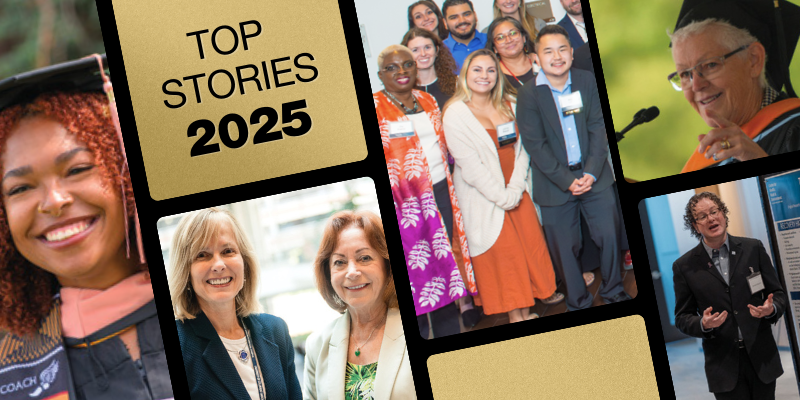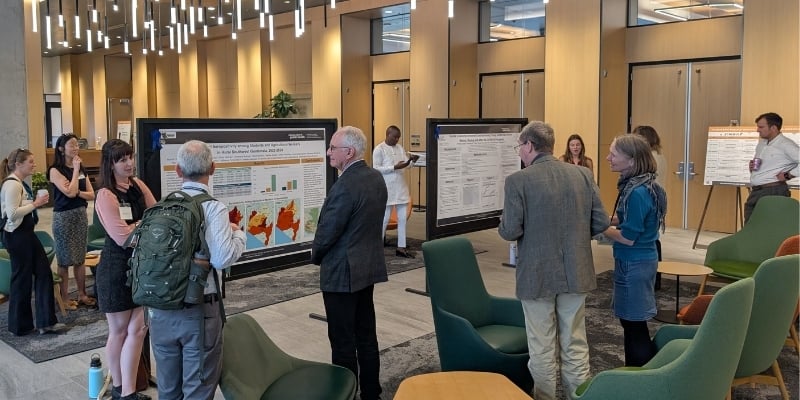One of the pillars of the Colorado School of Public Health is its collaborative model that leverages the unique strengths of three Colorado universities into one school. Comprising the University of Colorado Anschutz Medical Campus, Colorado State University and the University of Northern Colorado, the collaboration now also manifests as internally-funded, inter-institutional research projects, thanks to a new jointly-funded grant program.
Jon Samet, Dean of ColoradoSPH, and Alan Rudolph, Vice President for Research at CSU, each contributed matching funds to establish a one-year program for research projects that involve one principal investigator from two of the three universities. These grants are designed as pilot grants, providing each selected team with $30,000 to fund seed projects that have the potential for larger, long-term research.
For Cathy Bradley, ColoradoSPH’s Associate Dean for Research, these grants reflect general trends in the field of public health toward team science. “We understand that a research problem involves so much—the social determinants of health, exposures, the environment, all of these things—and no one researcher has all of the skills, all those areas of expertise,” she said. “In the past, our model for research was very much a single RO1 investigator [a major National Institute for Health grant] thinking about they wanted to do, then trying really hard to sell that idea.”
Katie Dickinson, one of the funded investigators in the Department of Environmental and Occupational Health, sees institutionally-based grants as providing flexibility to address these cultural shifts in a way federal funding can’t yet. “I think there’s a lot of recognition that if you talk about public health, just funding lab science is not going to solve things,” she said. “There’s a lot of lip service [about funding interdisciplinary and public engagement projects], but the structures of [NIH grant review] study sections haven’t necessarily caught up to it.” Calls for NIH grant proposals still tend to be focused on very specific areas of research, principal investigators who individually demonstrate all of the skills required to complete the project, and lab-based or intervention research with specific hypotheses.
Faculty of the three universities each have different areas of strength, making them the perfect complements for holistic, interdisciplinary public health research. Bradley says that CSU faculty are known for their work in environmental science, fitness and nutrition, and agricultural health, while CU Anschutz faculty shine in core public health methodology, chronic disease, and social determinants of health. UNC faculty bring strength in community health and community-engaged research. This inter-institutional grant program is designed to capitalize on each university’s strengths in ways that investigators might not consider without an explicit funding mechanism.
Another important component of the new inter-institutional grant program is that it is designed explicitly for pilot projects. Most NIH research funding requires applicants to provide data that explain why they think their proposed project will work, but those data are nearly impossible to acquire without funding—a catch-22. By funding a pilot grant program, ColoradoSPH and CSU are providing investigators with the opportunity to develop the questions, cultivate relationships and get the preliminary data necessary to be able to apply for NIH grants. “This is such a critical phase, and we really wouldn’t be able to do this kind of work without a funding source that recognizes the need for it,” Dickinson said. For the school and university partners, the ideal goal is a return on investment in the form of grants that bring outside money into the universities. Bradley says that she would love for the investigators to use the outcomes of this grant to receive NIH RO1 funding in the future, but “if that doesn’t happen this first round, if people just got together and did collaborative research and we were able to show ourselves as a consortium school of public health working together in research, then were successful.”
A bran new way to combat malnutrition
The first collaborative study seeks to determine whether rice bran, a byproduct of the rice milling process, can be used as a nutritional supplement for chronically malnourished mothers and infants in the rural Trifinio region of Guatemala. Co-PI Dr. Elizabeth Ryan (Food Science and Human Nutrition, CSU) has previously studied rice bran as a dietary supplement in Mali and Nicaragua. Co-PI Dr. Molly Lamb (Epidemiology, CU Anschutz) has extensive experience conducting public health research studies and interventions in the Trifinio region and has built a relationship with the community and has connections with field site staff. This proof-of-concept study will find local sources of rice bran, assess whether the preparation of rice bran-enhanced foods is feasible, and determine whether mothers and infants find the enhanced foods palatable. The initial findings will set the stage for a larger study looking at the effects of 6-12 months of daily rice bran consumption on child growth outcomes. “The timing is right,” said Ryan. “The rice bran work that I have been doing in other countries is practical to translate to Guatemala given the current status and existing infrastructure at the Trifinio site with other public health [CU Anschutz] faculty.”
Vaping and VapoRub
The second inter-institutional study will investigate whether e-cigarette use by Colorado youth increases risk for flu infection by altering the function of macrophage immune cells. Co-PI Sheryl Magzamen (Epidemiology, CSU) specializes in air pollution epidemiology and community-based studies of environmental pollutants. Co-PI Alison Bauer (Environmental and Occupational Health, CU Anschutz) has a background in basic toxicology and pharmacology research. The collaboration will allow this project to look at the effects of e-cig liquid on viruses both in people and in cells. In people, the project will study changes in the population of viruses and bacteria in the upper respiratory tract of e-cig users during flu season. In cells, it will look at whether exposure to the byproducts of e-cig liquid have an effect on virus-infected immune cells in an artificial environment. Magzamen and Bauer hope to be able to use these data to apply for larger grants to study additional viruses and products of e-cig liquid.
Public health in public housing
The third study in the ColoradoSPH at CU-CSU pilot grant program will look at health outcomes of physical and social exposures in mixed-income public housing developments as part of the Department of Housing and Urban Development’s Choice Neighborhood Initiative (CNI). Co-PI Ellison Carter (Civil and Environmental Engineering, CSU) has a research background in indoor air quality and interventions in low-income housing and their relationship to energy, housing and transportation policy. Co-PI Katie Dickinson (Environmental and Occupational Health, CU Anschutz) studies the role of social behaviors and social networks in risk behavior. This project aims to establish a multi-institutional, transdisciplinary community research lab that will investigate the long-term impacts of Denver’s CNI-funded public housing redevelopment on multiple health determinants and endpoints. “This redevelopment is trying to rethink the way we do public housing from the understanding that housing is so fundamental to health. Is there a better way to provide public housing assistance to folks in a way that can be health-promoting and improve health outcomes for those that rely on these services?” said Dickinson. Dickinson and Ellison hope to use the next year to establish the relationships with community partners that will to identify comparison public housing communities and the structure of a long-term health outcomes study.
ColoradoSPH at CU Anschutz and CSU plan to co-host a research showcase next fall, where the results of the grants will be presented to Samet, Rudolph and the ColoradoSPH faculty research committee.






